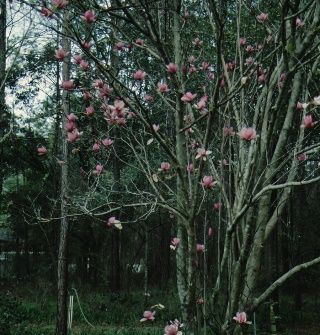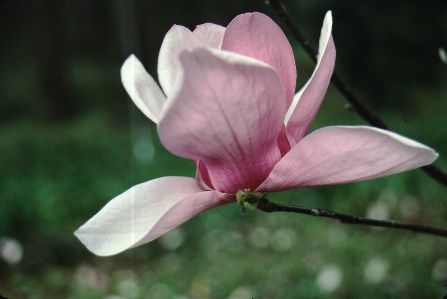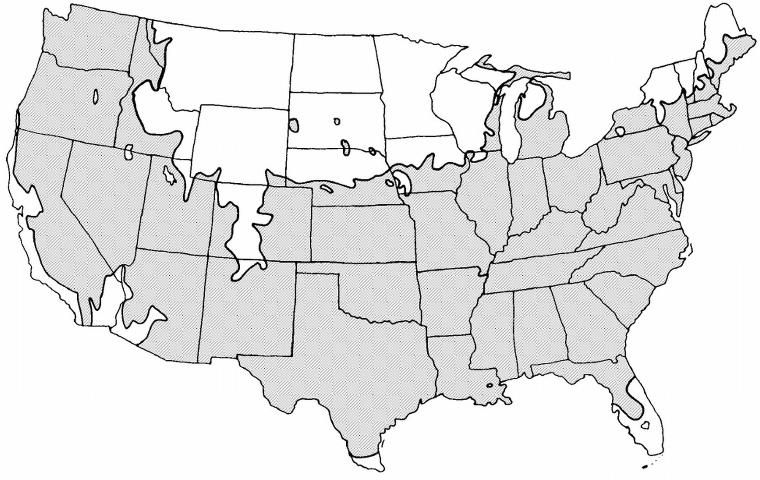Introduction
Young Japanese or saucer magnolia are distinctly upright, becoming more oval, then round by 10 years of age. Blooms open in late winter in the southern part of its range to early spring in the northern part of its range before the leaves emerge. Flowers are large, shaded in light pink on the outside of the petals and white on the inside, creating a spectacular flower display. Even young trees can develop a beautiful flower display. However, a late frost can often ruin the flowers in all areas where it is grown. In warmer climates, the late-flowering selections avoid frost damage, but some are less showy than the early-flowered forms, which blossom when little else is in flower.

Credit: Edward F. Gilman, UF/IFAS

Credit: Edward F. Gilman, UF/IFAS
General Information
Scientific name: Magnolia x soulangiana 'Coates'
Pronunciation: mag-NO-lee-uh x soo-lan-jee-AY-nuh
Common name(s): 'Coates' saucer magnolia
Family: Magnoliaceae
Plant type: shrub
USDA hardiness zones: 5 through 9A (Figure 3)
Planting month for zone 7: year-round
Planting month for zone 8: year-round
Planting month for zone 9: year-round
Origin: not native to North America
Invasive potential: not known to be invasive
Uses: near a deck or patio; container or above-ground planter; espalier
Availability: somewhat available, may have to go out of the region to find the plant

Credit:
Description
Height: 20 to 25 feet
Spread: 15 to 25 feet
Plant habit: upright; round
Plant density: open
Growth rate: moderate
Texture: coarse
Foliage
Leaf arrangement: alternate
Leaf type: simple
Leaf margin: undulate
Leaf shape: obovate
Leaf venation: pinnate
Leaf type and persistence: deciduous
Leaf blade length: 4 to 8 inches
Leaf color: green
Fall color: yellow
Fall characteristic: showy
Flower
Flower color: purple
Flower characteristic: spring flowering; winter flowering
Fruit
Fruit shape: irregular
Fruit length: 1 to 3 inches
Fruit cover: dry or hard
Fruit color: red
Fruit characteristic: rarely fruits
Trunk and Branches
Trunk/bark/branches: no thorns; typically multi-trunked or clumping stems
Current year stem/twig color: brown
Current year stem/twig thickness: medium
Culture
Light requirement: plant grows in part shade/part sun
Soil tolerances: clay; sand; loam; acidic
Drought tolerance: moderate
Soil salt tolerances: unknown
Plant spacing: 36 to 60 inches
Other
Roots: usually not a problem
Winter interest: plant has winter interest due to unusual form, nice persistent fruits, showy winter trunk, or winter flowers
Outstanding plant: plant has outstanding ornamental features and could be planted more
Pest resistance: long-term health usually not affected by pests
Use and Management
The tree is best used as a specimen in a sunny spot where it can develop a symmetrical crown. It develops an open canopy but flowers fine in a partially shaded spot. It can be pruned up if planted close to a walk or patio to allow for pedestrian clearance but probably looks its best when branches are left to droop to the ground. The light gray bark shows off nicely, particularly during the winter when the tree is bare.
Transplant in the spring, just before growth begins, and use balled and burlapped or containerized plants. Pruning wounds may not close well, so train plants early in their life to develop the desired form to avoid large pruning wounds.
Pests and Diseases
It is generally pest free, but scales of various types may infest twigs and foliage. Magnolia may be subject to leaf spots. Canker diseases will kill entire branches.